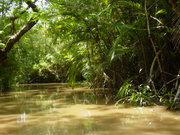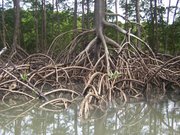Amazon Rainforest
|
|
The Amazon is a rainforest in South America. It encompasses 1.2 billion acres (7 million km²), with parts located within nine nations: Brazil (with 60% of the rainforest), Colombia, Peru, Venezuela, Ecuador, Bolivia, Guyana, Suriname and French Guiana. This forest represents over half of the planet's remaining rainforests. States or departments in four nations bear the name Amazonas for the Amazon.
| Contents |
The Amazon Basin
See Amazon Basin.
The forest lies in a basin drained largely by the Amazon River, with 1100 tributaries. This basin was formed in the Palaeozoic period, between 500 and 200 million years ago.
Biodiversity
The region is home to ~2.5 million insect species, tens of thousands of plants, and some 2000 birds and mammals. The diversity of plant species is the highest on earth with some experts estimating that one square kilometre may contain over 75,000 types of trees and 150,000 species of higher plants. One square kilometre of Amazon rainforest can contain about 90,000 tons of living plants. This constitutes the largest collection of living plants and animal species in the world. One in five of all the birds in the world live in the rainforests of the Amazon. To date, an estimated 438,000 species of plants of economic and social interest have been registered in the region with many more remaining to be discovered or cataloged. (Note: Brazil has one of the most advanced laws to avoid biopiracy, but enforcing it is a problem.)
Environmentalism
There has been concern among environmentalists for many years, regarding the deforestation of the region, stemming mainly from the fact that more than one fifth of the Amazon Rainforest has already been destroyed; and much more is threatened. Not only are environmentalists concerned about the loss of biodiversity which will result from the forest's destruction, they are also concerned about the release of the carbon which is held within the trees -- this carbon will accelerate global warming.
The deforestation of this area in the 1980s was largely considered catastrophic. Yet, in 1996, the Amazon was reported to have shown a 34 per cent increase in deforestation since 1992. A new report by a congressional committee says the Amazon is vanishing at a rate of 52,000 square kilometers (20,000 miles²) a year, over three times the rate for which the last official figures were reported, in 1994.
Environmentalists commonly stress the fact that there is not only a biological incentive to protecting the rainforest, but also an economic one. One square kilometer in the Peruvian Amazon has been calculated to have a value of $682,000 if intact forest is sustainably harvested for fruits, latex, and timber; $100,000 if clear-cut for commercial timber (not sustainably harvested); or $14,800 if used as cattle pasture.
The For硠A鲥a Brasileira has been using EMBRAER R-99 surveillance aircraft, as part of the SIVAM program, in an attempt to halt rainforest molestation. At a conference in July 2004, scientists warned that the rainforest will no longer be able to absorb the millions of tons of greenhouse gases annually, as it usually does, because of the increased pace of rainforest destruction. The large-scale cutting of trees begins a cycle in which farmers burn leftover jungle scrub to replenish the soil, which releases huge amounts of carbon dioxide (200 to 300 million tons in 2003) into the atmosphere, that are in turn absorbed by the rainforest.
9,169 square miles of rain forest were cut down in 2003 alone.
See also
External links
- Amazon conservation (http://www.junglephotos.com/conservation/conservation.html)


